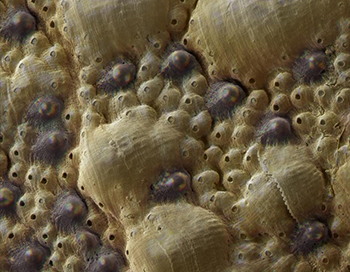
A light micrograph of a region of the chiton's shell surface with multiple small dark-pigmented eyes composed of aragonite. Credit: Wyss Institute at Harvard University
A multidisciplinary team of scientists reports having figured out how a chiton mollusk uses aragonite—a calcium carbonate material that makes up its hard, protective shell—to create hundreds of tiny eyes (Science, doi: 10.1126/science.aad1246). The chiton’s approach is one that many scientists and engineers want to copy: the creation of a dual-function material that combines strength with sensitivity to light.
Researchers, led by Harvard University’s (USA) Christine Ortiz and Joanna Aizenberg, used high-resolution microscopy, X-ray crystallography and computer modeling to discover structures in the chiton eye that are similar to a cornea, lens and retina in a human eye. The chiton lens is made of large aragonite crystals that are aligned to allow light to pass through with minimal impedance. The large size of the crystal grains reduces the number and area of grain boundaries, which, in turn, minimizes light scattering. To test the aragonite lenses’ ability to form images, the researchers suspended them in water and projected images through them. They were able to capture recognizable images of fish—one of many chiton predators—through the lenses.
Although the eyes create weak spots in the armor, the authors say they don’t see it as a failure in the chitons’ design, but rather an acceptable compromise in function. In other words, the ability to see predators is worth some weak spots in the chiton’s hard shell. It’s this materials-level trade-off that interests researchers in the field of multifunctional structural material design.
“To date, artificial materials that have the ability to perform multiple and often structurally opposite functions are not available,” Aizenberg notes in a press release. “But studying different multifunctional biomaterials present in nature should ultimately allow us to deduce the key principles for this relatively new area of materials science.”
